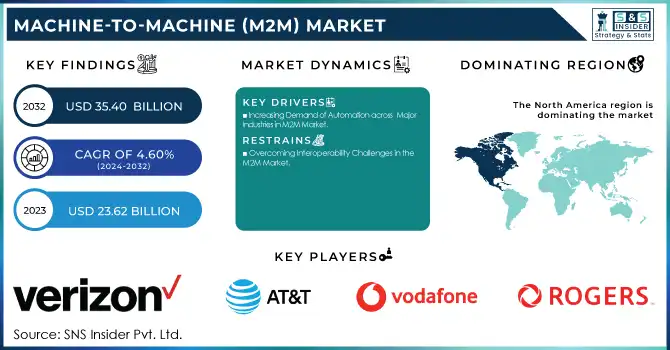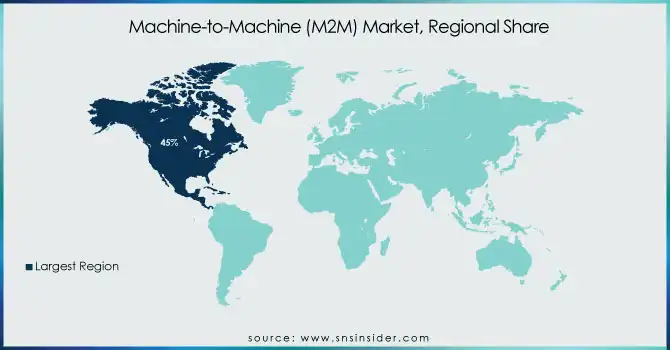Machine-To-Machine (M2M) Market Size & Trends:
The Machine-to-Machine (M2M) Market Size was valued at USD 23.62 billion in 2023 and is expected to reach USD 35.40 billion by 2032, growing at a CAGR of 4.60% from 2024 to 2032.
The rise of technological innovations is here, and with it, the region embracing the most is Asia pacific, leading the path for the advent of 5G, artificial intelligence and Internet of things. M2M adoption is driven by increased consumer interest in smart devices and connected services, although data privacy and cybersecurity issues remain widespread and cannot be ignored. One of the major market drivers is an increasing demand for automation in sectors such as healthcare, automotive, and manufacturing which facilitates efficiency and low cost.

To get more information on Machine-to-Machine (M2M) Market - Request Free Sample Report
M2M (Machine-to-Machine) Market Dynamics
Drivers:
-
Increasing Demand of Automation across Major Industries in M2M Market
Rising requirement for automation is one of the major factors, which is driving the Machine-To-Machine (M2M) Market, especially for manufacturing, healthcare, and logistics. M2M technologies help in the real-time monitoring and control of machines and reduces downtime in manufacturing, which improves production efficiency. Machine-To-Machine solutions in healthcare not only support remote patient monitoring but also accelerate readiness regarding diagnosis and treatment while also reducing operational costs of the healthcare providers. M2M systems in logistics reduce delays and maximize the utilization of resources due to improved supply chain management, shipment tracking, and fleet performance. M2M Automation assistance to automate business processes, reduce expenses, and improve overall business efficiency, all the industries.
Restraints:
-
Overcoming Interoperability Challenges in the M2M Market
The absence of interoperability across devices and platforms creates a formidable hurdle for the M2M market. Integration between devices, networks, and software is challenging, as M2M solutions often depend on different communication protocols. The fragmentation makes it harder to range up M2M systems because organizations cannot be certain that different parts will operate seamlessly together. Without a common framework, implementation complexity is increased, adoption is delayed and costs are raised, particularly for enterprises in pursuit of deploying M2M solutions at scale. Hurdling these interoperability challenges is essential for facilitating wider market expansion and breakthrough.
Opportunities:
-
5G Networks Fuelling the Expansion of the Machine-To-Machine Market
The rise of 5G technology is an opportunity for growth in the M2M market, given that 5G will offer faster data speeds, lower latency, and more devices that are connected. These innovations provide the ability to connect in the real-time, which is essential for industries like autonomous vehicles in instances they need to exchange data, closely and rapidly for the safety and navigation. In healthcare, 5G supports remote patient monitoring, telemedicine, and quick transmission of large medical data. Further, 5g can also enable IOT-based systems in smart cities that include Smart grids, intelligent transportation, and connected infrastructure which in turn will promote the growth of Machine to Machine solutions and make them scalable as well.
Challenges:
-
Machine-To-Machine Market Regulatory & Compliance Challenges
With the global expansion of Machine-To-Machine M2M technologies, one of the greatest hurdles facing companies is the myriad of regulatory regimes that are both industry-specific and region-specific in nature. There are many unique rules on data privacy and security compliance, as well as device compliance in various countries that adds complexity for businesses to roll out M2M solutions globally. These inconsistencies in regulations can lead to time-to-market delays, higher operational costs, and compliance risks. In addition, organizations in sectors with heavy regulation such as finance, healthcare, and telecommunications are more severely impacted than others, making it difficult to implement Machine-To-Machine solutions.
Machine to Machine Market Segmentation Analysis
By Technology
The 2G segment has been dominating the Machine-To-Machine Market representing approximately 39% of the total revenue in 2023. Even with the emerging of sophisticated technologies such as 5G and LTE, 2G still occupies a significant part of the world, mainly due to the presence of infrastructures in most countries and the most low-bandwidth use cases in sectors such as automotive, healthcare, and logistics. But with the progress of technology, 2G should face a slow extinction.
The Zigbee segment is expected to see the fastest growth in the M2M market from 2024 to 2032, owing to its benefits such as low power consumption, reliability, and low cost, making it suitable for applications in smart home, industrial and healthcare sectors.
By Component
In 2023, the sensors segment dominated the Machine-To-Machine (M2M) market, contributing around 35% of the total revenue. M2M applications are used for monitoring, tracking and controlling many fields, and are considered as the backbone of sensors that collect real time information. These play a significant role in the automotive, healthcare, industrial automation, smart cities industries, allowing the connected fabrics to speak and work with each other.
The actuators component is projected to be the fastest-growing segment in the Machine-To-Machine Market throughout the estimated period from 2024 to 2032. For automating equipment, transforming electrical signals into physical activity, enabling automation and remote control in several firms such as manufacturing, automotive, and robotics, actuators are competent. With industries moving toward automation to improve overall operational efficiency, the actuator market is expected to grow, especially in areas such as robotics, industrial machinery and smart systems.
By Application
The consumer electronics segment dominated the M2M market in 2023 with around 40% of total revenue. M2M also improves the features of some of the consumer electronics such as a smart appliance, smart devices, wearables, home automation, etc. Growing trend of smart homes and IoT integration along with increased demand for connected devices, are some major influencing factors, which have been accelerating the growth of this segment.
The Information Technologies (IT) segment is the fastest-growing application in the Machine-To-Machine market over the forecast period 2024-2032 . With the ongoing trend for businesses to digitally transform, M2M technologies are now critical to increasing operational efficiency, securing data and communication in real-time. M2M spans cloud computing, data centers and network management in IT, where it is used for automation, monitoring and management of complex systems.
M2M Market Regional Outlook
In 2023, North America dominated the Machine-To-Machine (M2M) market, accounting for approximately 45% of the total revenue. Due it rich infrastructure, high technology adoption rates, and the existence of some of the key global players such as Verizon, AT&T, and Cisco. With an especially dominant United States leading the change, and with the urgent need for automation, monitoring, and real-time data collection across industries such as healthcare, automotive, and logistics, M2M solutions have been rapidly adopted. Moreover, the rising need for smart cities, IoT-enabled devices, and expansion of 5G networks further drives M2M applications, which will help North America remain the largest M2M market globally.
Asia-Pacific is expected to be the fastest-growing region in the Machine-To-Machine Market from 2024 to 2032. The increasing number of M2M applications in several industries in the region is being accelerated by the rapid uptake of innovative technologies including 5G, Internet of Things (IoT), and smart devices. The M2M market growth is boosted by smart cities, industrial automation, healthcare, and transportation, with China, India, Japan, and South Korea, emerging as the largest countries developing in these fields. Meanwhile, the demand for energy-efficient solutions and the rising emphasis on digitalization and connectivity in the Asia-Pacific region are expected to make this region a key driver for the global M2M market during the forecast period.

Get Customized Report as per Your Business Requirement - Enquiry Now
Key Players
Some of the major key Players in Machine-To-Machine (M2M) Market along with their product:
-
Verizon Communications, Inc. (Wireless Communication Services, IoT Solutions)
-
AT&T, Inc. (Wireless Communication Services, IoT Solutions)
-
Vodaphone Group (Telecommunication Services, IoT Solutions)
-
Rogers Communications (Wireless Communication Services, IoT Solutions)
-
Axeda Corp. (IoT Software Solutions)
-
Atmel Corp. (Microcontrollers, Semiconductors)
-
Cisco Systems (Networking Equipment, IoT Solutions)
-
Imetrik, Inc. (M2M Communication Solutions)
-
Cypress Semiconductor Corp. (Semiconductors, IoT Solutions)
-
Infineon Technologies (Semiconductors, IoT Solutions)
-
Freescale Semiconductor, Inc. (Microcontrollers, Processors)
-
NEC Corp. (Telecommunication Solutions, IoT Systems)
-
NTT Docomo, Inc. (Mobile Communication Services, IoT Solutions)
-
Novatel Wireless, Inc. (Mobile Broadband Solutions, IoT Devices)
-
Huawei Technologies Co. Ltd. (Telecommunications Equipment, IoT Solutions)
-
Google Inc. (Cloud Services, IoT Solutions)
-
Alcatel-Lucent S.A. (Telecommunication Equipment, IoT Solutions)
List of suppliers who provide raw material and component
-
Intel Corporation
-
Qualcomm Inc.
-
Broadcom Inc.
-
NXP Semiconductors
-
STMicroelectronics
-
Texas Instruments
-
Infineon Technologies
-
Cypress Semiconductor Corp.
-
Honeywell International Inc.
-
Murata Manufacturing Co., Ltd.
Recent Development
-
On October 10, 2024, Vodafone, Sumitomo Corporation, and Mastercard announced their partnership to introduce embedded payments technology, enabling autonomous payments between machines in sectors like freight, shipping, and logistics.
-
On May 16, 2024, Infineon Technologies introduced its new PSOC Edge MCU family, designed for machine learning (ML) applications, with the E81, E83, and E84 models offering scalable performance, features, and memory.
| Report Attributes | Details |
|---|---|
| Market Size in 2023 | USD 23.62 Billion |
| Market Size by 2032 | USD 35.40 Billion |
| CAGR | CAGR of 4.60% From 2024 to 2032 |
| Base Year | 2023 |
| Forecast Period | 2024-2032 |
| Historical Data | 2020-2022 |
| Report Scope & Coverage | Market Size, Segments Analysis, Competitive Landscape, Regional Analysis, DROC & SWOT Analysis, Forecast Outlook |
| Key Segments | • By Technology (2G, Wi-Fi, Ethernet, Zigbee, Power-Line) • By Component(Actuators, Sensors, Memory, RFID, Power Modules, Communication Modules) • By Application(Consumer Electronics, Information Technologies (IT), Retail, Transportations & Consumer Electronics, Healthcare, Security and Surveillance) |
| Regional Analysis/Coverage | North America (US, Canada, Mexico), Europe (Eastern Europe [Poland, Romania, Hungary, Turkey, Rest of Eastern Europe] Western Europe] Germany, France, UK, Italy, Spain, Netherlands, Switzerland, Austria, Rest of Western Europe]), Asia Pacific (China, India, Japan, South Korea, Vietnam, Singapore, Australia, Rest of Asia Pacific), Middle East & Africa (Middle East [UAE, Egypt, Saudi Arabia, Qatar, Rest of Middle East], Africa [Nigeria, South Africa, Rest of Africa], Latin America (Brazil, Argentina, Colombia, Rest of Latin America) |
| Company Profiles | Verizon Communications, Inc., AT&T, Inc., Vodafone Group, Rogers Communications, Axeda Corp., Atmel Corp., Cisco Systems, Imetrik Machine to Machine Solutions, Inc., Cypress Semiconductor Corp., Infineon Technologies, Freescale Semiconductor, Inc., NEC Corp., NTT Docomo, Inc., Novatel Wireless, Inc., Huawei Technologies Co. Ltd., Google Inc., Alcatel-Lucent S.A. |

